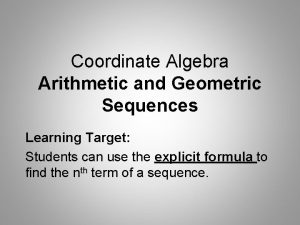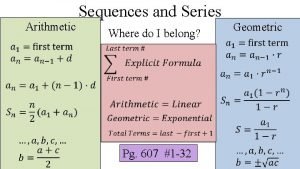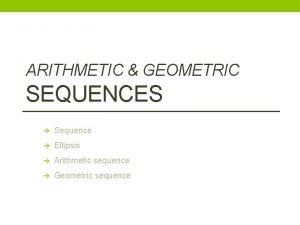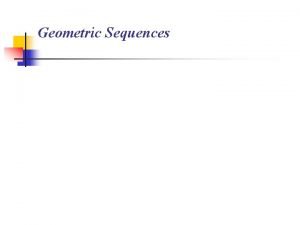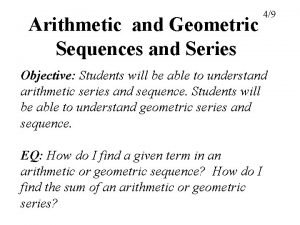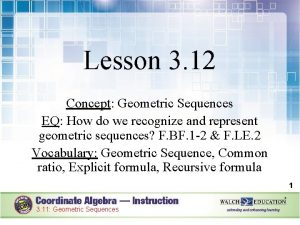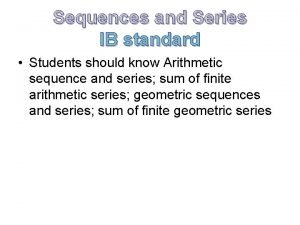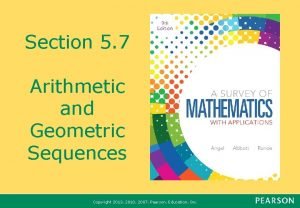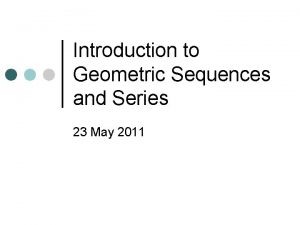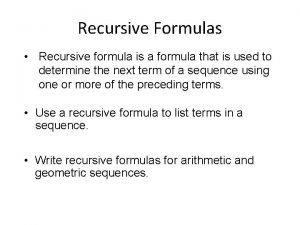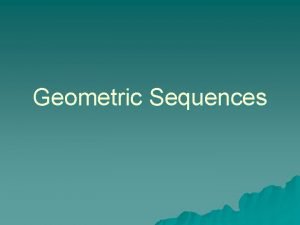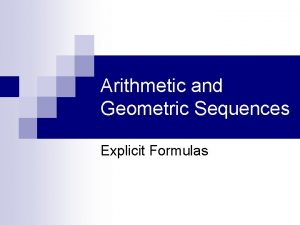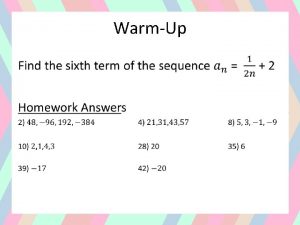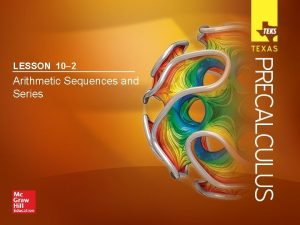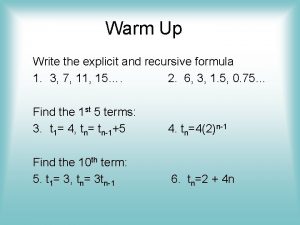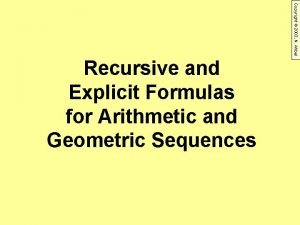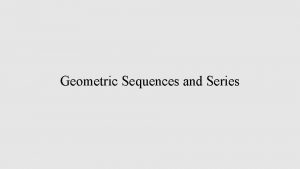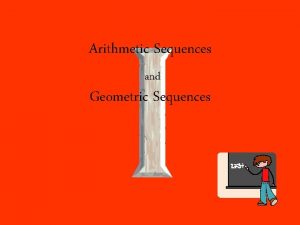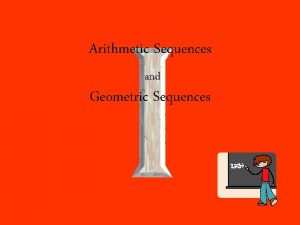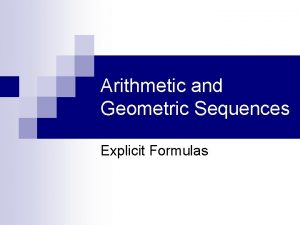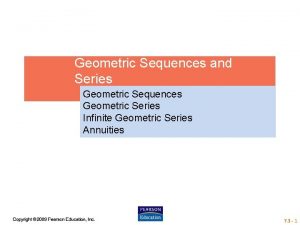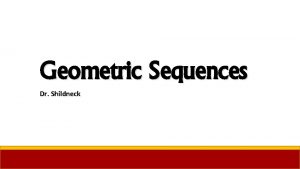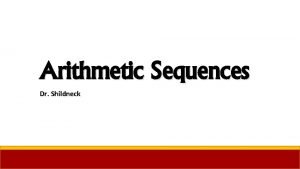Arithmetic and Geometric Sequences Explicit Formulas n A

















- Slides: 17

Arithmetic and Geometric Sequences Explicit Formulas

n A "sequence" (or "progression", in British English) is an ordered list of numbers; the numbers in this ordered list are called "elements" or "terms".

n n A sequence may be named or referred to as "A" or "An". The terms of a sequence are usually named something like "ai" or "an", with the subscripted letter "i" or "n" being the "index" or counter. So the second term of a sequence might be named "a 2" (pronounced "ay-sub-two"), and "a 12" would designate the twelfth term. Note: Sometimes sequences start with an index of n = 0, so the first term is actually a 0. Then the second term would be a 1. The first listed term in such a case would be called the "zero-eth" term. This method of numbering the terms is used, for example, in Javascript arrays. Don't assume that every sequence and series will start with an index of n = 1.

Arithmetic Sequences n n The two simplest sequences to work with are arithmetic and geometric sequences. An arithmetic sequence goes from one term to the next by always adding (or subtracting) the same value. For instance, 2, 5, 8, 11, 14, . . . and 7, 3, – 1, – 5, . . . are arithmetic, since you add 3 and subtract 4, respectively, at each step.

n The number added (or subtracted) at each stage of an arithmetic sequence is called the "common difference" d, because if you subtract (find the difference of) successive terms, you'll always get this common value. Find the common difference and the next term of the following sequence: 3, 11, 19, 27, 35, . . . The difference is always 8, so d = 8. Then the next term is 35 + 8 = 43.

n For arithmetic sequences, the common difference is d, and the first term a 1 is often referred to simply as "a". Since you get the next term by adding the common difference, the value of a 2 is just a + d. The third term is a 3 = (a + d) + d = a + 2 d. The fourth term is a 4 = (a + 2 d) + d = a + 3 d. an = a 1 + (n – 1)d

Examples: Find a formula for an and find the 10 th term n 2, 6, 10, 14, 18, … n 17, 10, 3, -4, -11, -18, …

Examples: n Find the n-th term (formula) and the first three terms of the arithmetic sequence having a 4 = 93 and a 8 = 65. Since a 4 and a 8 are four places apart, then I know from the definition of an arithmetic sequence that a 8 = a 4 + 4 d. 65 = 93 + 4 d – 28 = 4 d – 7 = d 93 = a + 3(– 7) 93 + 21 = a 114 = a OR 65 = a + 7(– 7) 65 + 49 = a 114 = a

Solution an=114+(n-1)(-7) =114 -7 n+7 n an=121 -7 n n n a 1=114, a 2=107, a 3=100

Examples: n Find the n-th term (formula) and the tenth term of the arithmetic sequence having a 2 = 2 and a 5 = 16. an=-8/3+(n-1)(14/3) n an =14/3 n-22/3 n n a 10=118/3

Geometric Sequences A geometric sequence goes from one term to the next by always multiplying (or dividing) by the same value. n So 1, 2, 4, 8, 16, . . . and 81, 27, 9, 3, 1, 1/3, . . . are geometric, since you multiply by 2 and divide by 3, respectively, at each step n

The number multiplied (or divided) at each stage of a geometric sequence is called the "common ratio" r, because if you divide (find the ratio of) successive terms, you'll always get this common value. Find the common ratio and the seventh term of the following sequence: 2/9, 2/3, 2, 6, 18, . . . The ratio is always 3, so r = 3. Then the sixth term is (18)(3) = 54 and the seventh term is (54)(3) =162 n

n For geometric sequences, the common ratio is r, and the first term a 1 is often referred to simply as "a". Since you get the next term by multiplying by the common ratio, the value of a 2 is just ar. The third term is a 3 = r(ar) = ar 2. The fourth term is a 4 = r(ar 2) = ar 3. an = a 1 (n – 1) r

Examples: Find a formula for an and find the 10 th term n 1, 3, 9, 27, 81, … n 64, -32, 16, -8, 4, …

Example n Find the n-th (formula) and the 26 th term of the geometric sequence with a 5 = 5/4 and a 12 = 160. These two terms are 12 – 5 = 7 places apart, so, from the definition of a geometric sequence, I know that 7 160 = (5/4)(r ) 128 = r 7 2=r 4 5/4 = a(2 ) = 16 a 5/64 = a a 12=a 5 r 7 11 160 = a(2 ) = 2048 a OR 160/2048 =5/64= a

Solution an=5/64(2)(n-1) n an=5/128(2)n n n a 26=2, 621, 440

Example n Find the n-th (formula) and the 11 th term of the geometric sequence with a 3 = 12 and a 6 = 96. an=3(2)(n-1) n an=3/2(2)n n n a 11=3072
 Explecit formula
Explecit formula Arithmetic series formula
Arithmetic series formula Geometric and arithmetic sequences formulas
Geometric and arithmetic sequences formulas Formula for finite geometric series
Formula for finite geometric series Sum formula for geometric sequence
Sum formula for geometric sequence Arithmetic and geometric sequences and series
Arithmetic and geometric sequences and series Lesson 3: arithmetic and geometric sequences
Lesson 3: arithmetic and geometric sequences Sequence and series formulas pdf
Sequence and series formulas pdf How to find terms in a geometric sequence
How to find terms in a geometric sequence Geometric and arithmetic sequences
Geometric and arithmetic sequences Recursive formula for geometric sequence
Recursive formula for geometric sequence Geometic series
Geometic series Arithmetic and geometric formulas
Arithmetic and geometric formulas 10-2 practice arithmetic sequences and series answer key
10-2 practice arithmetic sequences and series answer key 10-2 arithmetic sequences and series
10-2 arithmetic sequences and series Arthimetic sequence
Arthimetic sequence Explicit and recursive formula
Explicit and recursive formula Recursive vs explicit rule
Recursive vs explicit rule
